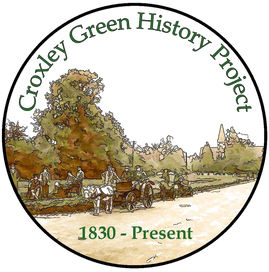A stroll down New Road - Appendix 3
The Census of New Road, Croxley Green, Hertfordshire.
as at April 1891
The Enumerator was Mr Joseph Payne,
of No. 2 New Road. (No. 1 on the Census schedules)
Information has been taken from facsimiles of the
Census schedules held at the Public Record Office,
in conjunction with Ordnance Survey Maps of 1896/8 and 1914
House numbers in New Road did not exist at this period, although individual cottages in a row were often given numbers. The collated information is given in columnar form:
Col.1 – Census Schedule ref. – This follows the order of houses in New Road – along the even side and back up the odd side, EXCEPT for some duplicated numbers – here listed with the suffix “b”
Col. 2 – No. in house group if shown Col. 3 – Group of houses e.g. Albion Terrace
Col. 4 – Possible house No. today. Col. 5 – Name of Head of Household
An exercise to try and marry up present day locations and Census details,
by
Jim Hughes and Richard Lee, Croxley Green, October 2006.
as at April 1891
The Enumerator was Mr Joseph Payne,
of No. 2 New Road. (No. 1 on the Census schedules)
Information has been taken from facsimiles of the
Census schedules held at the Public Record Office,
in conjunction with Ordnance Survey Maps of 1896/8 and 1914
House numbers in New Road did not exist at this period, although individual cottages in a row were often given numbers. The collated information is given in columnar form:
Col.1 – Census Schedule ref. – This follows the order of houses in New Road – along the even side and back up the odd side, EXCEPT for some duplicated numbers – here listed with the suffix “b”
Col. 2 – No. in house group if shown Col. 3 – Group of houses e.g. Albion Terrace
Col. 4 – Possible house No. today. Col. 5 – Name of Head of Household
An exercise to try and marry up present day locations and Census details,
by
Jim Hughes and Richard Lee, Croxley Green, October 2006.
Your browser does not support viewing this document. Click here to download the document.
Notes.
1. House Numbers: where there are gaps in the sequence of house numbers compared to Census schedule numbers, an explanation has been given where possible, for example, Numbers 144-166 have no entry as the land was occupied by the Dickinson’s Institute, adjacent to Dickinson Avenue, and there were no residents. In other cases plots had not yet been developed.
2. Named blocks of Cottages: If the names of Villas, cottages, terraces etc are named in the 1891 census but NOT on the building today they are listed in standard typeface, e.g. “Victoria Terrace”; if they are named in the 1891 census and ARE STILL on the buildings today they are in standard BOLD typeface, e.g. “Louise Gardens”; if they are NOT named in the 1891 census but are in current use , they are shown in BOLD ITALIC typeface, e.g. “Coxhill Cottages”; if they have been identified from the 1902 Peacock’s Directory but are not in current use they are shown in brackets, e.g. “(Westeria Cottage)”. Those in inverted commas, e.g. “Croxley Green” have no address or house number details at all so may well not be in New Road at all!
3. Odd numbers – there was far less development on this side, and to some extent the allocation of street numbers in this list is open to question, although it is believed to be fairly accurate. Confirmed reference points are Springfield cottages Nos. 209/211, Ethel Villas 57/59, and The Hawthorns 17, and although many of the gaps listed are supported by evidence from the maps, it does make accurate allocation of house numbers harder.
5. Census Ref Nos. – we have numbered some of the Census Ref Nos with a suffix “a” or “b”. This is because a few houses in New Road near to The Green were enumerated by a different census taker (covering The Green itself and Scots Hill) and therefore some have the same Census Ref No. Where this has occurred, those on the main census have been given the suffix “a” and those on the second census the suffix “b”. This will become clearer when looking at the original census sheets.
1. House Numbers: where there are gaps in the sequence of house numbers compared to Census schedule numbers, an explanation has been given where possible, for example, Numbers 144-166 have no entry as the land was occupied by the Dickinson’s Institute, adjacent to Dickinson Avenue, and there were no residents. In other cases plots had not yet been developed.
2. Named blocks of Cottages: If the names of Villas, cottages, terraces etc are named in the 1891 census but NOT on the building today they are listed in standard typeface, e.g. “Victoria Terrace”; if they are named in the 1891 census and ARE STILL on the buildings today they are in standard BOLD typeface, e.g. “Louise Gardens”; if they are NOT named in the 1891 census but are in current use , they are shown in BOLD ITALIC typeface, e.g. “Coxhill Cottages”; if they have been identified from the 1902 Peacock’s Directory but are not in current use they are shown in brackets, e.g. “(Westeria Cottage)”. Those in inverted commas, e.g. “Croxley Green” have no address or house number details at all so may well not be in New Road at all!
3. Odd numbers – there was far less development on this side, and to some extent the allocation of street numbers in this list is open to question, although it is believed to be fairly accurate. Confirmed reference points are Springfield cottages Nos. 209/211, Ethel Villas 57/59, and The Hawthorns 17, and although many of the gaps listed are supported by evidence from the maps, it does make accurate allocation of house numbers harder.
5. Census Ref Nos. – we have numbered some of the Census Ref Nos with a suffix “a” or “b”. This is because a few houses in New Road near to The Green were enumerated by a different census taker (covering The Green itself and Scots Hill) and therefore some have the same Census Ref No. Where this has occurred, those on the main census have been given the suffix “a” and those on the second census the suffix “b”. This will become clearer when looking at the original census sheets.


